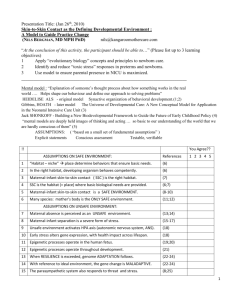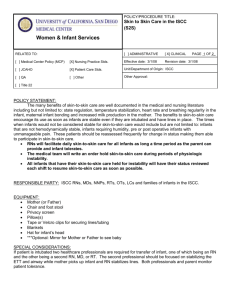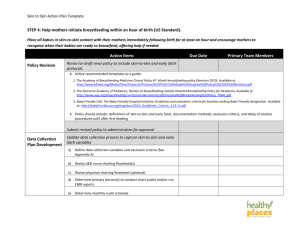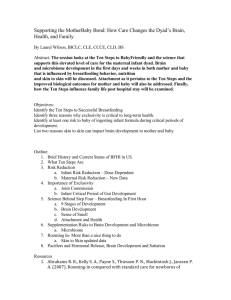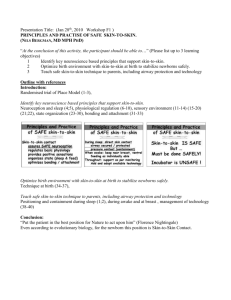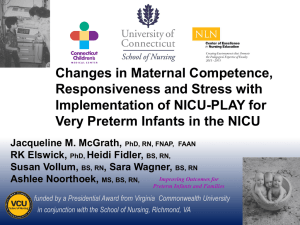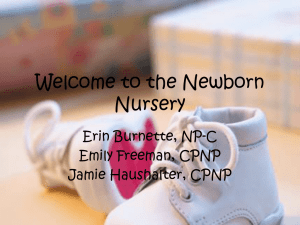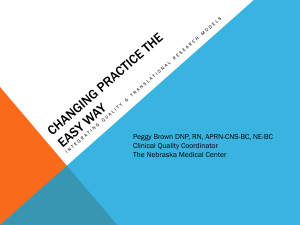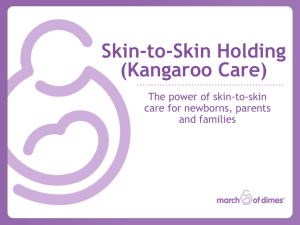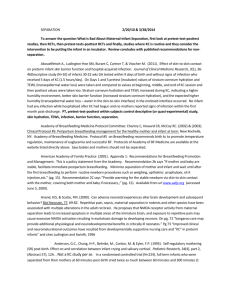Reference list - Skin to Skin Contact
advertisement
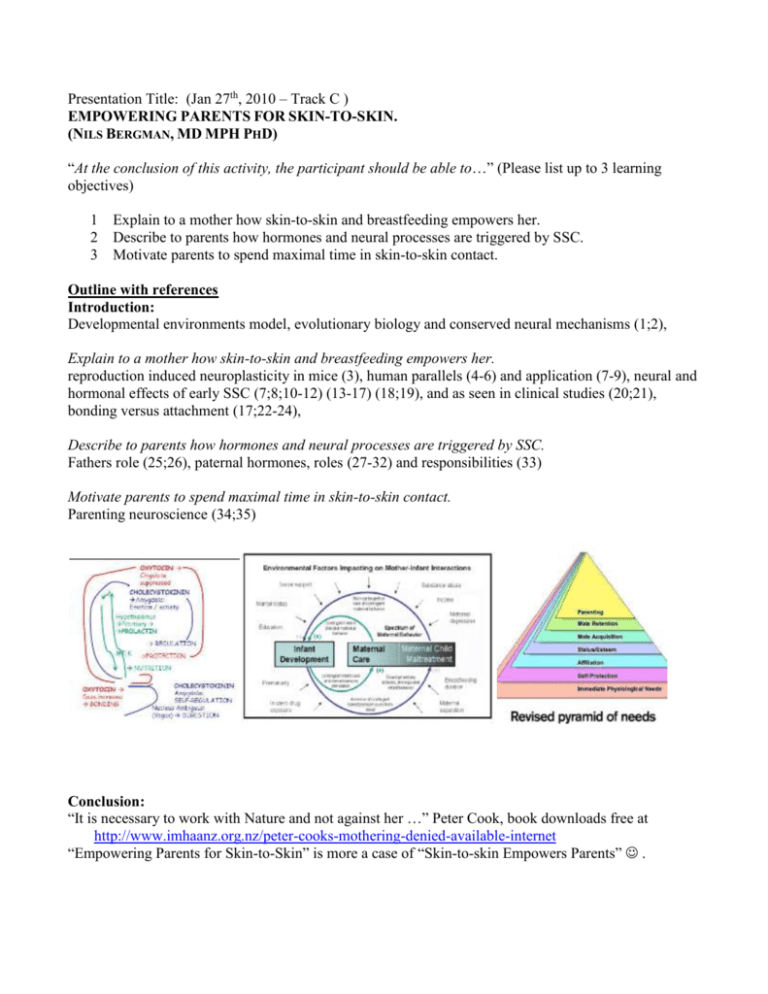
Presentation Title: (Jan 27th, 2010 – Track C ) EMPOWERING PARENTS FOR SKIN-TO-SKIN. (NILS BERGMAN, MD MPH PHD) “At the conclusion of this activity, the participant should be able to…” (Please list up to 3 learning objectives) 1 2 3 Explain to a mother how skin-to-skin and breastfeeding empowers her. Describe to parents how hormones and neural processes are triggered by SSC. Motivate parents to spend maximal time in skin-to-skin contact. Outline with references Introduction: Developmental environments model, evolutionary biology and conserved neural mechanisms (1;2), Explain to a mother how skin-to-skin and breastfeeding empowers her. reproduction induced neuroplasticity in mice (3), human parallels (4-6) and application (7-9), neural and hormonal effects of early SSC (7;8;10-12) (13-17) (18;19), and as seen in clinical studies (20;21), bonding versus attachment (17;22-24), Describe to parents how hormones and neural processes are triggered by SSC. Fathers role (25;26), paternal hormones, roles (27-32) and responsibilities (33) Motivate parents to spend maximal time in skin-to-skin contact. Parenting neuroscience (34;35) Conclusion: “It is necessary to work with Nature and not against her …” Peter Cook, book downloads free at http://www.imhaanz.org.nz/peter-cooks-mothering-denied-available-internet “Empowering Parents for Skin-to-Skin” is more a case of “Skin-to-skin Empowers Parents” . Reference List (1) Meaney MJ, Szyf M. Maternal care as a model for experience-dependent chromatin plasticity? Trends in Neurosciences 2005;28(9):456-63. (2) Despopoulos A, Silbernagl S. Color atlas of physiology. 3rd revised and enlarged ed. Stuttgard: Georg Thieme Verlag; 1986. (3) Kinsley CH, Lambert KG. Reproduction-induced neuroplasticity: Natural behavioural and neural alterations associated with the production and care of offspring. J Neuroendocrinol 2008;20:51525. (4) Bramson L, Lee JW, Moore E, Montgomery S, Neish C, Bahjri K et al. Effect of early skin-toskin mother--infant contact during the first 3 hours following birth on exclusive breastfeeding during the maternity hospital stay. Journal Of Human Lactation: Official Journal Of International Lactation Consultant Association 2010 May;26(2):130-7. (5) Caspi A, Williams B, Kim-Cohen J, Craig IW, Milne BJ, Pouldon R et al. Moderation of breastfeeding effects on the IQ by genetic variation in fatty acid metabolism. PNAS 2007;104(47):18860-5. (6) Mandel D, Lubetzky R, Dollberg S, Barak S, Mimouni FB. Fat and Energy Contents of Expressed Human Breast Milk in Prolonged Lactation. Pediatrics 2005 September 1;116(3):e432-e435. (7) Graven SN. Early neurosensory visual development of the fetus and newborn. Clin Perinatol 2004 June;31(2):199-216, v. (8) Righard L, Alade MO. Effect of delivery room routines on success of first breast-feed. Lancet 1990 November 3;336(8723):1105-7. (9) Widstrom A-M, Lilja G, Aaltomaa-Michalias P, Dahllof A, Lintula M, Nissen E. Newborn behaviour to locate the breast when skin-to-skin: a possible method for enabling early self-regulation. Acta Paediatrica 2010;1-7. (10) Czank C, Henderson JJ, Kent JC, Lai CT, Hartmann PE. Hormonal control of the lactation cycle. In: Hale TW, Hartmann P, editors. Textbook of Human Lactation. 1st ed. Amarillo, Texas: Hale Publishing, L.P.; 2007. p. 89-111. (11) Gregg C, Shikar V, Larsen P, Mak G, Chojnacki A, Yong VW et al. White matter plasticity and enhanced remyelination in the maternal CNS. J Neurosci 2007 February 21;27(8):1812-23. (12) Handwerger S, Freemark M. Role of placental lactogen and prolactin in human pregnancy. Adv Exp Med Biol 1987;219:399-420.:399-420. (13) Bosch OJ, Meddle SL, Beiderbeck DI, Douglas AJ, Neumann ID. Brain oxytocin correlates with maternal aggression: link to anxiety. J Neurosci 2005 July;%20;25(29):6807-15. (14) Carter CS, Grippo AJ, Pournajafi-Nazarloo H, Ruscio MG, Porges SW. Oxytocin, vasopressin and sociality. Progress In Brain Research 2008;170:331-6. (15) Leng G, Meddle SL, Douglas AJ. Oxytocin and the maternal brain. Curr Opin Pharmacol 2008 December;8(6):731-4. (16) Modney BK, Hatton GI. Maternal behaviors: evidence that they feed back to alter brain morphology and function. Acta Paediatr Suppl 1994 June;397:29-32. (17) Ross HE, Young LJ. Oxytocin and the neural mechanisms regulating social cognition and affiliative behavior. Front Neuroendocrinol 2009 October;30(4):534-47. (18) Uvnas-Moberg K, Widstrom AM, Marchini G, Winberg J. Release of GI hormones in mother and infant by sensory stimulation. Acta Paediatr Scand 1987 November;76(6):851-60. (19) Weller A, Feldman R. Emotion regulation and touch in infants: the role of cholecystokinin and opioids. Peptides 2003 May;24(5):779-88. (20) Bigelow AE, Littlejohn M, Bergman N, McDonald C. The relation between early mother-infant skin-to-skin contact and later maternal sensitivity in South African mothers of low birth weight infants. Infant Mental Health Journal 2010 May;31(3):358-77. (21) Browne JV. Early relationship environments: physiology of skin-to-skin contact for parents and their preterm infants. Clin Perinatol 2004 June;31(2):287-98, vii. (22) Lenzi D, Trentini C, Pantano P, Macaluso E, Iacoboni M, Lenzi GL et al. Neural basis of maternal communication and emotional expression processing during infant preverbal stage. Cerebral Cortex (New York, N Y : 1991) 2009 May 11;19(5):1124-33. (23) Petrovic P, Kalisch R, Pessiglione M, Singer T, Dolan RJ. Learning affective values for faces is expressed in amygdala and fusiform gyrus. Soc Cogn Affect Neurosci 2008 June;3(2):109-18. (24) Klaus MH, Kennell JH, Klaus PH. Bonding. Addison-Wesley Publishing Company, Inc; 2007. (25) Fleming AS, Corter C, Stallings J, Steiner M. Testosterone and prolactin are associated with emotional responses to infant cries in new fathers. Horm Behav 2002 December;42(4):399-413. (26) Wynne-Edwards KE. Hormonal changes in mammalian fathers. Horm Behav 2001 September;40(2):139-45. (27) Fegran L, Helseth S, Fagermoen MS. A comparison of mothers' and fathers' experiences of the attachment process in a neonatal intensive care unit. Journal of Clinical Nursing 2008 March 15;17(6):810-6. (28) Gloppestad K. Initial separation time between fathers and their premature infants: comparison between two periods of time. Nordic Journal of Nursing Research & Clinical Studies 1995;15(2):10-7. (29) Gloppestad K. Parents' skin to skin holding of small premature infants: differences between fathers and mothers. Vard Nord Utveckl Forsk 1996;16(1):22-7. (30) Gloppestad K. Experiences of maternal love and paternal love when preterm infants were held skin to skin and wrapped in blankets: -- differences between two types of holding [Norwegian]. Nordic Journal of Nursing Research & Clinical Studies / V+Ñrd i Norden 1998 March;18(1):2330. (31) Levy-Shiff R, Sharir H, Mogilner BM. Mother and father preterm infant relationship in the preterm nursery. Child Dev 1989;60(1):93-102. (32) Tomlinson S, Rothenberg AM, Carver DL. Behavioral interaction of fathers with infant and mothers in the postpartum period. J Nurse Midwifery 1991;36:232-9. (33) Cook P. Mothering denied. 2008. (34) Swain JE, Lorberbaum JP, Kose S, Strathearn L. Brain basis of early parentinfant interactions: psychology, physiology, and in vivo functional neuroimaging studies. Journal of Child Psychology & Psychiatry 2007 March;48(3/4):262-87. (35) Kenrick DT, Griskevlelus V, Neuberg SL, Schaller M. Renovating the Pyramid of Needs: Contemporary Extensions Built Upon Ancient Foundations. Perspective on Psychological Science 2010;5(3):292-314. (33): download from http://www.imhaanz.org.nz/peter-cooks-mothering-denied-available-internet

